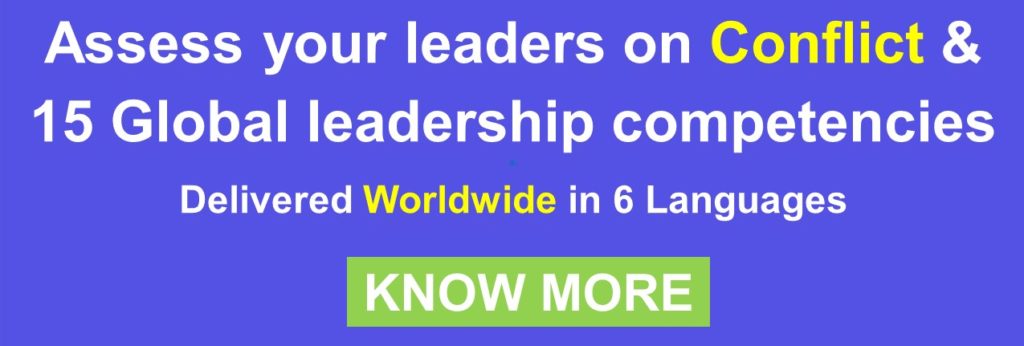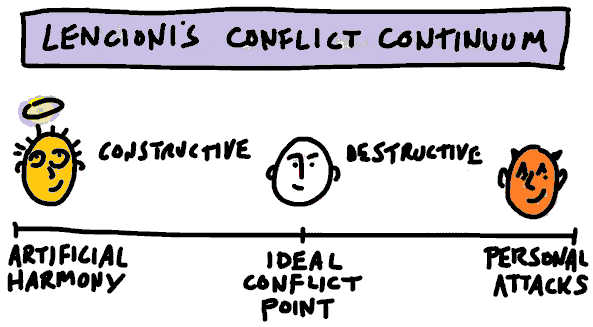
Conflict management at workplace is one of the essential skills for managers and team leaders. Having the right conflict resolution strategies can make the difference between a constructive conflict – where the goal is to come to the best solution for a particular issue.
A destructive conflict – where emotions run high, tempers may flare, relationships are strained, and performance suffers. Unresolved conflict is expensive. It wastes time and money. It is often the case in many workplaces. Fortunately, with proper conflict management at the workplace, it is also easy to address.
Here are some examples of workplace conflicts
• Manager and subordinate disagree on the performance evaluation
• Manager gives detailed instructions on tasks, but the employee hates the manager’s “micromanagement”
• During discussion, one employee, tends to raise his voice, other feels insulted, and it starts an argument
• Heated arguments and hurt feelings between departments – during the budget discussion meeting
• Giving feedback on an assignment – boss thinks it was bad, the employee completely disagrees
And there are many more that may you see at your workplace.
Conflict management definition
Conflict is a serious disagreement between two or more people or groups, usually because of the differences in their opinions, intentions, needs, or interests. Conflict arises when opposing parties are not able to come to an agreement or a compromise.
Conflict management definition – the process and techniques of managing conflict at the workplace to reduce the negative impact of conflict while taking advantage of the positive impact of any conflict.
Is conflict good or bad?
That brings us to the next question. Is conflict good or bad? Can conflict have a positive impact?
The work we do today is complex, uncertain, ambiguous, and constantly changing. There are no clear answers, and there are no decisions that are 100% correct.
Any plan or strategy is a hypothesis and the best guess based on the information available at the time. It has to be proven right through the process of trial, error, learning, and course correction.
Hence, conflict of ideas is essential to fostering learning, creativity, and innovation, better decision-making, and improved performance on the team.
On the other hand, destructive conflicts in organizations can lead to a variety of undesirable outcomes. Stress, anxiety, strained relationships, decreased productivity, missed deadlines, poor customer service, and higher turnover are some of the negative effects of a destructive conflict.
Conflict management at the workplace and having the right conflict management strategies are essential to ensure that team members have a balanced outlook on the conflict. Conflict is inevitable. Conflict of “ideas” is even desirable.
Conflict is not a problem. Conflict can be good, or it cannot be good bad. The way team members perceive conflict and the way leaders approach and manage conflict makes all the difference.
Patrick Lencioni’s concept of the conflict continuum
Patrick Lencioni, the author of the book – The Five Dysfunctions of a Team, proposes the conflict continuum concept.
At one end is artificial harmony, where everyone agrees, only superficially. At the other end is destructive conflict – where people are at one another’s throats.
Artificial harmony
If people remain silent and avoid conflict, it leads to what Lencioni calls artificial harmony. Everyone on the team agrees to everything, but only superficially. They avoid conflict in the meeting. They hold back their ideas and opinions during the meeting.
But then there is the meeting after the meeting! Around the water cooler, at the coffee break, where they question the ideas and decisions made in the meeting. Needless to say, they are not committed to the decisions and course of action.
They may even sabotage the decisions and course of action taken, especially because their ideas were not heard in the meeting. Artificial harmony has a negative impact on the engagement, commitment, and performance of the team.
Image Source – https://1.bp.blogspot.com/-ZSIBr6aEE4I/VuCvaMGBntI/AAAAAAAADH8/LHSKtIXAaWk/s1600/Lencioni-5.png
Teams have to learn and be comfortable to engage in constructive conflict. Conflict allows all ideas, opinions, points of view to be put out in the open.
They can then be listened to, discussed, and debated. The ultimate goal of the team is to come to the best possible solution to a work problem.
Unless different points of view are considered and evaluated, you may leave many good ideas on the table.
Destructive conflict
However, conflict can also get out of hand if it is not managed properly. Tempers may flare. People dig in their heels. They want to get their way. They are unwilling to listen to the other’s point of view.
There are personal attacks and insults. Relationships are strained. Opposing parties not only avoid collaborating on future projects, but they may also even attempt to sabotage others’ efforts.
The ideal conflict point
Somewhere between the two extremes, probably right in the middle, is the ideal conflict point. Everyone’s ideas are considered and debated, and decisions are made. The benefit of ideal conflict is that it allows a better commitment from the team to the final decision.
When everyone’s ideas are considered and listened to, people commit to the final decision, even if it was not the decision they had proposed.
Lencioni observes that people tend to err on the side of artificial harmony not to spoil their relationships with team members. He suggests that teams should try to move towards the ideal conflict point and not fear going a little beyond it to the other side.
The real test of a team’s health is when teams can go past the ideal conflict point and then return to normal without any collateral damage. Once teams have done this, performance accelerates.
Differences are inevitable – destructive conflict is preventable
Why does conflict arise? We all have different backgrounds, education, experiences, attitudes, perceptions, needs, and abilities. No two individuals are exactly alike, and no two individuals will always have the same opinion in every situation.
We see the world through our own unique perspective. It is through the lens of opinions, assumptions, experiences, and biases.
Unfortunately, our unique perspective is subjective, incomplete, flawed, and distorted. We think that we see reality as it is. The truth is that we all see our own little version of reality.

Five blind men and the elephant
A fantastic example of this is illustrated by the story of five blind men and the elephant. The first blind man holds the elephant’s tail and concludes that the elephant is like a rope.
The second blind man grabs the elephant’s leg and proclaims that the elephant is like a tree’s trunk. The third blind man leans against the elephant’s side and declares that the elephant is like a wall. The fourth blind man holds the elephant’s ear and thinks that the elephant is like a fan.
The fifth blind man holds the elephant’s trunk and concludes that the elephant is like a python.
Each one of these five blind men is both right and wrong. Right because from their perspective and their lens of the world, their assumptions are correct.
However, they are also wrong. To get the whole picture, we must look at the elephant from all perspectives. To resolve the problem, we need to consider all perspectives (each one of them is probably partially right) and understand the whole problem (be able to look at the whole elephant)
Two main sources of workplace conflicts
The main sources of workplace conflicts are interpersonal reasons and organizational sources. Here are a few examples of both
1. Interpersonal sources of conflicts
a. Difference in personalities of the people involved
b. Difference in communication styles
c. Difference in motivation
d. History of working together
e. Difference in education, background, experience, approaches, etc.
2. Organizational sources of conflicts
a. Unclear job descriptions
b. Ambiguity in roles
c. Competition for limited resources
d. Company politics and silos
e. Perception of inequality (or favoritism)
Conflict management at the workplace – Conflict resolution steps
There are many tools and frameworks available to understand and resolve conflicts. I am going to discuss two popular tools and their conflict resolutions steps
Conflict resolutions strategies with the LECSR Tool
LECSR is an acronym<>
L – Listen
E – Empathize
C – Clarify the issue
S – Seek Permission
R – Resolve
The LECSR tool allows conflict management at the workplace through both conflict prevention and conflict resolution. As soon as you see the signs of a disagreement turning into a conflict, call the involved parties and apply the six steps of LECSR to the situation.
Listen
When we speak, we are only repeating what we already know. In the example of five blind men and the elephant, each person may end up repeating what they know.
Listening allows others to share their perspective so that the listener can consider other perspectives. It also conveys to the speaker that you are interested in their perspective.
Listening is one of the key leadership skills. Listening is an active process. Almost all of us can become better listeners at any age or any stage of our careers.
Listen without interrupting. Listen without judgment. Keep an open mind and be curious. Listening does not necessarily mean that you agree with the other person’s perspective. It means that you understand their perspective.
Paraphrase what the other person said and get a confirmation of your understanding of their perspective. If emotions are high, allow other parties to vent their feelings without interruption and without taking them personally. Be genuinely interested and concerned.
Here are some pointers
“Tell me more about….”
“Can you give me an example of that?”
“When, how, where, what happened….”
Empathize
Empathy is the ability to put yourself in the other person’s shoes. To see, understand, and feel things that the other person is experiencing.
Again, it does not mean that you agree with their perspective or position. It means that you understand them. Empathy is not sympathy.
Sympathy is when you feel compassion or pity for someone’s predicament. Empathy is experiencing the situation as the other person sees, feels, or understands.
With most reasonable people, they want to share their inputs. They want to be heard and understood. This is a critical step. Unless this hurdle is overcome, people may not be able to move to the next step.
Here are some pointers
“I understand where you are coming from.”
“If I were in your situation, I would probably be doing the same thing.”
Clarify the Issue (conflict)
After listening and empathizing, the next step is to clarify the conflict situation.
Before resolving the conflict, establish a clear understanding of the situation from all sides. Paraphrase the situation and explain the positions of the conflicting parties.
Here are some pointers
• “What you’re saying is… is that correct?”
• “If my understanding is right, this is what you are proposing.”
Seek Permission
If you are lucky, you may end up diffusing conflict just by listening, empathizing, and clarifying. The involved parties may now be ready to sit together and resolve the conflict themselves.
However, if the conflict is not yet resolved, avoid the tendency to jump in with advice. Unwanted advice is almost always unwelcome.
Too many managers and leaders tend to jump into “advice” and “problem solving” mode. There is a critical step here to seek permission first.
When you seek to understand, you may find you tend to problem-solve instead of listening. Keep on track by being someone who seeks permission.
Before you ask questions, make sure that you have asked the person if they are ready for you to ask. (Perhaps they have more to share first.)
You can wait to tell your side after the other person has expressed all of his/her concerns and feels clearly understood.
Here are some pointers
• “May I bring up a few points that you may have missed?”
• “Can I propose a couple of ideas to consider?”
• “Now that we understand each other, can we brainstorm some ideas to move forward?”
Resolve the Issue
Now that both parties have listened, empathized, clarified the issue, asked for permission, and discussed options – they can start to resolve the conflict together.
A conversation framed in this way prevents escalation of conflicts and allows the issues to be resolved. Sometimes we may have to agree to disagree or have a solution that does not satisfy all the parties completely.
With the conflict resolution steps in LECSR, conflict can be brought out instead of suppressed. Conflicts can be diffused, and they may seldom turn into destructive conflict.
Read: Everything you ever wanted to know about executive coaching and leadership coaching
Conflict management at work – Conflict resolution strategy
Conflict resolutions strategies using the Crucial Conversations framework
Another viral and research-based tool for resolving conflict is the framework of the Crucial conversation. It is from the best-selling book – Crucial Conversations: Tools for Talking When Stakes are High by authors Kerry Patterson, Joseph Grenny, Ron McMillan, and Al Switzer
What is a crucial conversation?
The book defines a crucial conversation as – “A discussion between two or more people where the stakes are high, opinions vary, and emotions run strong.”
In other words, a crucial conversation is a situation prone to conflict. Managing crucial conversations is akin to conflict management at work.
Crucial conversations have three characteristics.
• The stakes are high – may be a budget allocation meeting or a performance appraisal conversation
• Opinions vary – each department thinks that they deserve a larger portion of the budget, the employee thinks she deserves the promotion – boss may think otherwise
• Emotions run strong – High stakes and varying opinions are often accompanies by strong emotions. If not handled properly, things may quickly get out of hand during a crucial conversation.
Examples of crucial conversations (or conflict situations)
Crucial conversations are part of our professional and personal lives. Apart from the examples shared earlier, here are some examples from the book or conflict situations or crucial conversations
• Giving the boss feedback about her behavior
• Critiquing a colleague’s work
• Talking to a team member who isn’t keeping commitments
• Talking to a coworker who behaves offensively or makes suggestive comments
• Giving an unfavorable performance review
• Talking to a coworker about a personal hygiene problem
• Ending a relationship
• Asking a friend to repay a loan
• Asking a roommate to move out
Read: The Collateral Damage of Poor Leadership Behaviors
Three possible outcomes of conflicts aka crucial conversations
1. We can avoid them.
2. We can face them and handle them poorly.
3. We can face them and handle them well.
This is akin to our fight or flight response that is programmed in the primitive parts of our brains. Our brains are continuously scanning our environment for any danger.
This comes from the time when early humans lived in the African Savannahs. This is a survival mechanism that has helped humans survive against stronger and faster predators.
When you see a sabre tooth tiger – taking quick action – either be ready to fight the tiger or flight – run-away was the key to survival. In our modern world, we rarely face any life-threatening situations. Crucial conversations and conflict situations trigger this response.
We can fight the situation. We run away from the situation. We can get violent, or we can remain silent. Neither of the two options is productive.
We have to learn to manage crucial conversations well and learn conflict resolution strategies.
The crucial conversation framework offers a research-based conflict resolution strategy.

Image Source – https://www.thinksmarterworld.com/crucial-conversations/
7 step process for conflict management at the workplace
Here are the 7 steps of conflict management strategy using the framework of the Crucial conversation
Step 1: Start with Heart
In the heat of the conflict, we sometimes lose track of the desired outcome, and things may get personal. Start with heart means asking the following questions and keeping them in the forefront during the conflict resolution process.
• What is the outcome that I desire?
• What is really at stake here?
Here are some more questions to ask before going into conflict resolution discussions
• What do I really want for myself?
• What do I really want for others?
• What do I really want for the relationship?
• How would I behave if I really wanted these results?
Almost always, our relationships at work are not transactional. Ideally, we would want to resolve the issue and maintain a good working relationship. Knowing this allows us to keep our emotions under check.
Step 2: Learn to Look
Look for signs of a crucial conversation between yourself and others. Indicators can be physical, emotional, or behavioral. Tightening of stomach muscles, anger or fear, shouting, pointing fingers, etc. We want to identify and reinforce the mutual purpose and create a dialogue around how to achieve a mutually beneficial outcome.
Monitor the conversation – are we in dialogue more, or have we moved to attack or defensiveness. Use statements like “It seems like we have moved away from dialogue into being stuck in our positions” or “I’m sorry. It seems I haven’t allowed you to explain your point of view.”
Step 3: Make it Safe.
When emotions tend to run high, and conversation has moved away from dialogue, do something to get back to safety. Offer apologies, humor (self-deprecating humor – a joke on self and not at other’s expense), a tea break, or a 10 minute time out are good ways to diffuse tension and make it safe again that the dialogue can proceed.
Read my article on – Psychological safety at work – Why you need it and how to develop it
Step 4: Master My Stories
As human beings, we cannot perceive reality as it is. We tell ourselves stories about the situation and make up our own version of reality in our heads. This stirs up emotions based on our interpretation of reality. And then we act accordingly. For example – Let’s say your spouse is late from work. What would be your reaction? It would depend on how you interpret the situation and what story you tell yourself.
If you tell a story that he/she may be involved in an accident, then your emotions may be of concern and worry. If you tell a story that he/she doesn’t care about you and cares only about work – you may feel angry and upset. If you tell a story that he/she is late because he/she may be cheating on you – you will probably have emotions of jealousy, anger, despair. How you behave when your spouse arrives home depends on the story you have told yourself.
It is very important to realize the stories we are telling ourselves about the situation during a crucial conversation. We may end up twisting facts, ignoring data, and living in our own imaginary world. Here are some pointers
• What is my story? How has my story led me to these conclusions and emotions?
• Do facts support my story?
• Separate your interpretations from the data and facts
• Change your story and revise your response accordingly
Step 5: State My Path
Start by stating your perspective and your interpretation of the event. State clearly that this is your version of the story. Use mitigating phrases. Use I statement instead of you. State facts, not opinions. Here are some pointers
“I have noticed that you arrived late three days last week.”
“I did not get any response from you for my last four emails.”
Step 6: Explore Other’s Paths
Just as you stated your path, the next step is allowing others to state their paths – how they arrived at their position in this conflict or crucial conversation. Be curious and non-judgmental. Listen with empathy. Paraphrase what you understand. Here are a few statements that will help you explore other’s paths.
“Here is how I see things. Do you see this differently?”
“What’s going on that makes you come to this conclusion?”
“I’d really like to get your take on this”
“This is how to see it. Have I misunderstood?”
This will allow both parties to understand each other. Emphasize the areas where you agree. Clarify areas where there is a difference of opinion. Once again, emphasize mutual purpose and mutual respect.
Step 7: Move to Action
Agree on the next steps. What will happen? Who will do it? By when? How will we report/monitor progress?
Read: Psychological safety at work: What is it and why do you need it
Conclusion
Conflicts at work and in personal lives are commonplace. Conflicts around ideas are desirable to find the best solution to a particular problem. However, conflicts may get out of hand if not managed properly. Conflict management in the workplace is an essential managerial and leadership skill.
The two conflict resolution strategies discussed were the LECSR tool and the framework of the Crucial conversation. Use them both to sharpen your conflict management skills in the workplace.
Get the best leadership coaching to improve conflict management skills for your leaders and teams
We offer Marshall Goldsmith coaching in India, the middle east, and southeast Asia. It is the best coaching program in India because it is the same executive coaching process used by Marshall Goldsmith to coach CEOs of Fortune 500 companies worldwide. We guarantee measurable leadership growth or don’t pay at all.
NAL Triple Advantage Leadership Coaching.
That delivers guaranteed and measurable leadership growth. It is based on a stakeholder-centered coaching process with a 95% effectiveness rate (in a study or 11000 leaders on 4 continents). It is used by companies ranging from startups to 150 of the Fortune 500 companies to develop their leaders.
Here are some of the salient benefits of NAL Triple Advantage Leadership Coaching
Time and resource-efficient: The leader does not have to leave work to attend training programs. We go to the leader and her team. And it only takes 1.5 hours per month. The rest of the time, the leader is working to implement with her team.
Separate and customized improvement areas for each leader: Every leader is different. One size fits all approach doesn’t work. Individual development areas for each leader aligned to the business strategy.
Involves entire team: Unlike most leadership programs, NAL Triple Advantage Leadership Coaching involves the leader’s entire team, and it has a cascading effect – increasing the team effectiveness and improving organizational culture.
The leader becomes the coach: for continuous improvement for leaders themselves and their teams. It is like kaizen for your leadership development.
Cost-Effective: Our entire one-year coaching engagement often costs less than sending the leader to a short-duration leadership program at any reputed B school.
Guaranteed and measurable leadership growth: as assessed – not by us – but anonymously rated by the leader’s own team members.
Pay us only after we deliver results! : We work with many of our clients on a pay for results basis. What does it mean? If the leaders don’t improve, you simply don’t have to pay us.
Schedule an exploratory 15-minute conversation with our leadership adviser today
Click the button below.
Reference
https://virtualspeech.com/blog/crucial-conversations
https://sourcesofinsight.com/crucial-conversations/ The crucial conversations framework for understanding and resolving conflicts
Velsoft – Conflict resolution – LECSR framework




